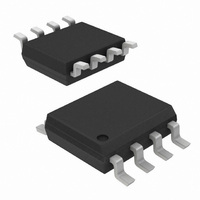ISL12022IBZ-T7A Intersil, ISL12022IBZ-T7A Datasheet - Page 17

ISL12022IBZ-T7A
Manufacturer Part Number
ISL12022IBZ-T7A
Description
IC RTC/CALENDAR TEMP SNSR 8SOIC
Manufacturer
Intersil
Type
Clock/Calendarr
Datasheet
1.ISL12022IBZ.pdf
(28 pages)
Specifications of ISL12022IBZ-T7A
Memory Size
128B
Time Format
HH:MM:SS (12/24 hr)
Date Format
YY-MM-DD-dd
Interface
I²C, 2-Wire Serial
Voltage - Supply
1.8 V ~ 5.5 V
Operating Temperature
-40°C ~ 85°C
Mounting Type
Surface Mount
Package / Case
8-SOIC (0.154", 3.90mm Width)
Lead Free Status / RoHS Status
Lead free / RoHS Compliant
Note that setting the IATR to the lowest settings (-31ppm)
with the default 32kHz output can cause the oscillator
frequency to become unstable on power-up. The lowest
settings for IATR should be avoided to insure oscillator
frequency integrity. If the lowest IATR settings are needed,
then the user is advised to disable the F
again to insure placing the oscillator in a stable condition.
ALPHA REGISTER (ALPHA)
The Alpha variable is 8 bits and is defined as the
temperature coefficient of Crystal from -40°C to T0, or the
Alpha Cold (There is an Alpha Hot register that must be
programmed as well). It is normally given in units of
ppm/°C
device uses a scaled version of the absolute value of this
coefficient in order to get an integer value. Therefore,
Alpha<7:0> is defined as the (|Actual Alpha Value| x 2048)
and converted to binary. For example, a crystal with Alpha of
-0.034ppm/°C
then converted to a binary number of 01000110b.
The practical range of Actual Alpha values is from
-0.020 to -0.060.
The ALPHA register should only be changed while the TSE
(Temp Sense Enable) bit is “0”. Note that both the ALPHA
and the ALPHA Hot registers need to be programmed with
values for full range temperature compensation.
BETA Register (BETA)
ADDR
0Dh
IATR05 IATR04 IATR03 IATR02 IATR01 IATR00
ADDR
0Ch
1
1
1
1
1
1
1
1
1
1
1
1
1
1
TABLE 12. IATR0 TRIMMING RANGE (Continued)
2
TSE
, with a typical value of -0.034. The ISL12022
D
7
7
1
1
1
1
1
1
1
1
1
1
1
1
1
1
2
BTSE BTSR BETA4 BETA3 BETA2 BETA1 BETA0
ALPHA6 ALPHA5 ALPHA4 ALPHA3 ALPHA2 ALPHA1 ALPHA0
is first scaled (|2048*(-0.034)| = 70d) and
6
6
TABLE 13. ALPHA REGISTER
0
0
0
0
0
0
1
1
1
1
1
1
1
1
5
5
TABLE 14.
0
0
1
1
1
1
0
0
0
0
1
1
1
1
17
4
4
1
1
0
0
1
1
0
0
1
1
0
0
1
1
3
3
OUT
0
1
0
1
0
1
0
1
0
1
0
1
0
1
2
and enable
2
TRIMMING
RANGE
1
-18
-19
-20
-21
-22
-23
-24
-25
-26
-27
-28
-29
-30
-31
1
ISL12022
0
0
TEMPERATURE SENSOR ENABLED BIT (TSE)
This bit enables the Temperature Sensing operation, including
the temperature sensor, A/D converter and AT/DT register
adjustment. The default mode after power-up is disabled
(TSE = 0). To enable the operation, TSE should be set to 1
(TSE = 1). When the temperature sensor is disabled, the initial
values for IATR and IDTR registers are used for frequency
control.
All changes to the IDTR, IATR, ALPHA and BETA registers
must be made with TSE = 0. After loading the new values,
TSE can be enabled and the new values are used. When TSE
is set to 1, the temperature conversion cycle begins and will
end when two temperature conversions are completed. The
average of the two conversions is in the TEMP registers. The
total time for temperature sense and conversion is
approximately 22ms from the time TSE = 1 write is completed.
TEMP SENSOR CONVERSION IN BATTERY MODE BIT
(BTSE)
This bit enables the Temperature Sensing and Correction in
battery mode. BTSE = 0 (default) no conversion, Temp
Sensing or Compensation in battery mode. BTSE = 1
indicates Temp Sensing and Compensation enabled in battery
mode. The BTSE is disabled when the battery voltage is lower
than 2.7V. No temperature compensation will take place with
V
FREQUENCY OF TEMPERATURE SENSING AND
CORRECTION BIT (BTSR)
This bit controls the frequency of Temperature Sensing and
Correction. BTSR = 0 default mode is every 10 minutes,
BTSR = 1 is every 1.0 minute. Note that BTSE has to be
enabled in both cases. See Table 15.
The temperature measurement conversion time is the same
for battery mode as for V
battery mode current will increase during this conversion time
to typically 68µA. The average increase in battery current is
much lower than this due to the small duty cycle of the
ON-time versus OFF-time for the conversion.
To figure the average increase in battery current, we take the
the change in current times the duty cycle. For the 1 minute
temperature period the average current is shown in
Equation 1:
ΔI
BAT
TABLE 15. FREQUENCY OF TEMPERATURE SENSING AND
BTSE
BAT
0
0
1
1
<2.7V.
=
0.022s
----------------- -
60s
BTSR
CORRECTION BIT
0
1
0
1
×
68μA
=
TC PERIOD IN BATTERY MODE
250nA
DD
mode, approximately 22ms. The
10 Minutes
1 Minute
OFF
OFF
June 23, 2009
FN6659.2
(EQ. 1)












